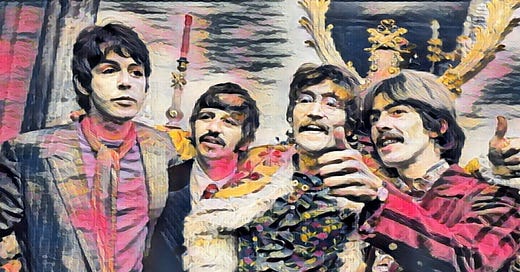EXCLUSIVE: Inside The Making of Sgt. Pepper: The Studio Drama and Great Moustache Debate That Changed Pop Forever!
A look back at the historic month when the Beatles revolutionized music and facial hair divided a generation
The untold story behind the making of Sgt. Pepper's Lonely Hearts Club Band - from secret costume fittings to orchestral mayhem
How the Beatles' moustaches sparked a cultural phenomenon and fan controversy
Paul McCartney's candid response to those first break-up rumors
May 1967 marked a pivotal moment in Beatles history, as revealed through the pages of their official fan magazine. While Beatlemania was evolving into something altogether more sophisticated, the band was putting the finishing touches to what would become their masterpiece.
PEPPER PERFECTION
After four months of intense recording sessions, the Fab Four were completing their most ambitious album to date. "Sgt. Pepper's Lonely Hearts Club Band" was about to revolutionize everything anyone thought they knew about pop music. George Martin spent countless hours in the studio, crafting what would become one of the most influential albums of all time.
The instrumentation broke all previous boundaries - they brought in three saxes, two trombones, and a French horn. Ringo had been working on a piano piece at home, crafting what he described as a "really great boogie number." Meanwhile, Paul jetted off to America to visit Jane Asher, somehow finding time between flights to pen new material.
THE FACIAL HAIR REVOLUTION
The Beatles' new moustaches became one of the most talked-about style choices of 1967. Letters flooded into the fan club office, with readers either declaring eternal devotion or utter disdain for the new facial furniture. The truth behind the whiskers was remarkably simple: George grew his for his spiritual journey to India, Paul followed suit before heading to Africa, and the others joined in simply because they fancied a change.
FASHION EVOLUTION
The band's fashion choices had become increasingly experimental. While Paul remained loyal to his signature lemon yellow recording jacket, the others pushed boundaries with psychedelic ties and elaborate costumes. Their style transformation reflected the changing times, moving far beyond their matching suit days.
RUMOURS AND REBUTTALS
Early break-up rumors had begun to circulate, prompting Paul to address them directly. In a candid interview, he explained that while band members were pursuing individual interests - George with his sitar studies and John's film projects - they remained committed to the group. The separate pursuits were simply a natural evolution of their creativity.
STUDIO INNOVATIONS
The recording techniques employed for Sgt. Pepper marked a dramatic departure from their earlier work. Gone were the days when a simple "yeah, yeah, yeah" would suffice. The incorporation of three saxes, two trombones, and a French horn for "Good Morning, Good Morning" demonstrated just how far they'd come. The band also participated in a secret costume fitting session for what would become their iconic album cover - a shoot that changed album artwork forever.
THE DYLAN EFFECT
Bob Dylan's arrival in London that spring proved significant. The folk legend spent his time in the capital antagonizing journalists, drawing massive crowds, and expressing genuine enthusiasm for the Beatles' musicianship. His approval meant something special - even to a band that had already conquered the world.
CHART CONTROVERSIES
When critics suggested the Beatles might be losing their chart dominance, John Lennon responded with characteristic directness. "First of all, we're still getting number one records," he stated in what became a famous retort. "Second, our shows are a sell-out. Third, would anybody who really believes the skids are under us care to come and tell us to our face?" It was a powerful reminder of the band's continuing confidence and success.
RINGO'S SECRET GARDEN
In what seemed like an unlikely hobby for a rock star, Ringo had developed a passion for gardening at his Weybridge home. His grounds boasted impressive rhododendrons reaching heights of 30 feet, with roses scattered throughout. The drummer took particular pride in showing visitors around his horticultural haven.
FAN CLUB PHENOMENA
The Beatles' fan club mail that month revealed fascinating insights into their devoted following. One letter writer staunchly defended the band against drug accusations, while others praised their loyalty to their partners - a marked contrast to the typical rock star lifestyle of the era. The letter section also highlighted the deep personal connections fans felt with individual band members, moving beyond the screaming teenager phase of earlier years.
FASHION FOOTNOTES
During a March recording session, Ringo appeared wearing an unusual collar fashioned from material Maureen had cut from one of her dresses. The unusual accessory, complemented by a fan-gifted zip-like brooch, exemplified how even their casual studio wear made fashion statements.
THE GETAWAY TALES
The band's experience at Weston-super-Mare demonstrated how intense their fame remained. With crowds ranging from 100 to 1,000 fans besieging stage doors, elaborate escape plans became necessary. Road manager Mal Evans often found himself left behind to handle equipment while the band made swift exits - a regular occurrence in their lives at the time.
Looking back, May 1967 represented a crucial moment in Beatles history. While recording what would become one of the most celebrated albums of all time, they were also navigating personal changes, fashion revolutions, and the constant pressure of unparalleled fame. The facial hair debate, though seemingly trivial, symbolized their transition from pop idols to serious artists. Everything was about to change - though few realized just how much at the time.
FINAL NOTES
In the months that followed, Sgt. Pepper's release would exceed all expectations, but during that May, it remained an exciting work in progress. George had recorded multiple numbers, though only one would make the final cut. The addition of orchestral elements and experimental recording techniques pointed toward a new direction in popular music - one that would influence generations to come.
[Note: The story of May 1967 captures a band at their creative peak, though none of them could have known they had less than three years left together.]




